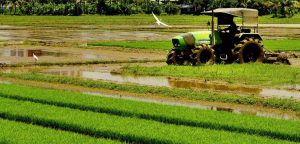An increased thrust on agricultural exports is well documented in the Agriculture Export Policy 2018 and is also visible through alterations in the tariffs and non-tariff measures.
India continues to be a net agriculture exporting economy, having a high share of primary commodity exports—rice, shrimp, bovine meat, sugar, tea, and spices. Most of its imports are processed products, mainly palm oil and sunflower oil. The key concern is the value of agri-imports has surged by four percentage points, touching an all-time high of $25 billion in FY18, which can possibly surpass the value of agri-exports, thus making India a net agri-importer. Going by the country’s mandate to accelerate the rate of agricultural growth and double farmers’ income by 2022-23, exports have to play a pivotal role. An increased thrust on agricultural exports is well documented in the Agriculture Export Policy 2018 and is also visible through alterations in the tariffs and non-tariff measures.
An initiative India should take is branding agri-products through steps such as geographical indication (GI), especially for organically-produced commodities that would realize higher returns in global markets. Establishing effective agricultural brands can help farmers gain a competitive advantage in ‘buyer-driven’ global markets. Some globally recognized brands (California almonds, Chilean wines, Swiss chocolates) enjoy a high stature in their respective product groups. Branded items usually fetch better prices can lead to brand loyalty, and are seen as a move towards a strong customer base. Branding adds value by differentiating the product and also because of the consumer perception that such products are of superior quality than unbranded ones.
India has about 300 registered GIs, but few have been used for commercial value addition. Two of India’s well-known GIs are Darjeeling tea and Basmati rice, but both seem to be minuscule in terms of market impact when compared with, say, Chilean wine or Danish cheese. While a program to promote branding and commercialization of GI products for exports has been initiated in the Directorate General of Foreign Trade policies during 2015-20, it is pertinent to take it to the next level.
India can choose Alphonso mango, Darjeeling tea, and Basmati rice and escalate them to the stature of California almonds or Swiss chocolates in terms of global acceptability. Indian Embassies abroad can act as a catalyst in guiding and promoting such products through food festivals, and displays at busy airports, encouraging top chefs and connoisseurs to highlight these. The Agriculture Department in the Dutch Embassy in New Delhi supports Dutch food producers in exploring Indian markets and bringing awareness about their expertise. In fact, lessons can also be learned from other countries in promoting brands. Many countries have opted for clustering, which is at the root of branding agricultural commodities and adding value to products. For example, France started this for wine, and soon after many other countries followed—Japan for Kobe beef, Colombia for Juan Valdez coffee, and New Zealand for Manuka honey. A celebrated example is that of Malaysia for having implemented a commodity branding program called Malaysia’s Best. It is an umbrella brand for selected horticultural products that guarantee quality and safety by Malaysian standards and good agricultural practices. The immediate benefit accrued is a significant increase in the exports of guavas, mangoes, and mangosteens—from $21.73 million in 2017 to $51.29 million in just a year.
Another reason that buttresses aggressive branding of agri-products is that government support if given, would be WTO-compliant as it is placed under the ‘green box’ instead of the ‘amber box’. Currently, India supports agri-exporters through duty drawback and under the Merchandise Export from India Scheme, which may carry the risk of being WTO non-compliant. It goes without saying that adequate budgetary allocations towards aggressive branding and packaging can encourage producers and exporters.
source: Financialexpress
Link:https://www.financialexpress.com/opinion/explained-how-geographical-indication-can-boost-agriculture-exports/1673864/



